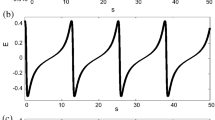Summary
Propagating acoustic-like disturbances generated by nuclear explosions have been observed to split in the lower ionosphere. The resulting two disturbances propagate vertically into the upper ionosphere at different speeds, the slower at ordinary sound speed in a neutral medium and the faster at almost twice the speed of sound.
The faster disturbance travels at the speed of an ion-acoustic wave in the ionic fluid. Such identification is prohibited theoretically by the large damping, or coupling, of the ionic mode to the neutral particle medium through ion-neutral elastic collisions; however, if inelastic collisions are included in the theory, the principal exothermic charge-exchange and charge-transfer reactions in the ionosphere provide enough additional coherent momentum in the charged particles to offset the losses through elastic collisions. It is shown quantitatively that in some regions of the ionosphere ionacoustic wave propagation can occur almost losslessly.
It is possible that under some conditions the ionosphere approaches an unstable chemical equilibrium that is relieved by the spontaneous generation of ion-acoustic wavelets. Various ionospheric observations are examined in which there is some evidence of the effects of ionospheric ionacoustic disturbances.
Similar content being viewed by others
References
S. Akasofu, Rept. Ionosphere Research Japan10 (1956), 227.
L. Brillouin,Wave Propagation in Periodic Structures, Sec. 3 (Dover Publications, New York 1953).
K. L. Chan andO. G. Villard, Jr., J. Geophys. Res.67 (1962), 973.
P. Chrzanowski, P. Green, K. T. Lemmon andJ. M. Young, J. Geophys. Res.66 (1961), 3727.
F. B. Daniels, S. J. Bauer andA. K. Harris, J. Geophys. Res.65 (1960), 1848.
Paul S. Epstein,Textbook of Thermodynamics, Sec. 46 (John Wiley and Sons, New York 1945).
E. E. Ferguson, F. C. Fehsenfeld, P. D. Goldan andA. L. Schneltekopf, J. Geophys. Res.70 (1965), 4323.
E. Fermi,Nuclear Physics (University of Chicago, 1949).
S. N. Ghosh, J. Geophys. Res.73 (1968), 309.
R. R. Hodges, Jr., J. Geophys. Res.72 (1967), 3455.
G. A. M. King andF. E. Roach, J. of Res., Nat'l Bureau of Standards65D, 2 (1961), 129.
H. Lamb,Hydrodynamics, Sec. 280 (Dover Publications, New York 1945).
G. M. Sessler, Phys. of Fluids7 (1964), 90.
P. J. Nawrocki andR. Papa,Atmospheric Processes (Geophys. Corp. of America, Bedford, Mass. 1961).
L. Oster, Rev. Mod. Phys.32 (1960), 141.
J. H. Piddington Geophys. J. Roy. Astron. Soc.2 (1959), 173.
L. Spitzer, Jr.,Physics of Fully Ionized Gases (Interscience, New York 1956).
C. R. Wilson andS. Nichparenko, Nature214 (1967), 1299.
J. R. Winkler, L. Peterson, R. Hoffman andR. Arnoldy, J. Geophys. Res.64 (1959), 597.
Author information
Authors and Affiliations
Rights and permissions
About this article
Cite this article
Wickersham, A.F. Detection and analysis of ion-acoustic waves in the ionosphere. PAGEOPH 80, 271–287 (1970). https://doi.org/10.1007/BF00880214
Received:
Issue Date:
DOI: https://doi.org/10.1007/BF00880214



